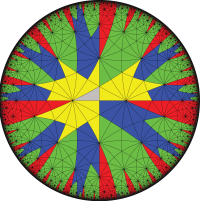 Natural Sciences
Natural Sciences
Not Your Basic Algebra
The mathematical problem had stood for 35 years. Ben Elias thought he’d take a crack at solving it.
It was 2009 and Elias was a graduate student at Columbia University. For decades, the field’s brightest minds had tried and failed to prove a complex problem from a complex corner of mathematics. At stake: a possible breakthrough in the understanding of—you guessed it— extremely complex concepts.
The field is “representation theory,” a mind-bending corner of the math realm that involves abstract algebraic concepts and how their components can be represented for study.
Elias is an expert, and his recent hire at UO as an assistant professor has bolstered a math department that already ranks as one of the world’s best in this area, along with the Massachusetts Institute of Technology.

Mathematicians Ben Elias and Geordie Williamson solved a long-standing problem, helping scientists who use pictures such as this to understand complex concepts in abstract algebra.
For decades, the UO department—despite being comparatively small—has produced leading research in representation theory, in turn drawing a critical mass of top-notch faculty in this field, said Hal Sadofsky, dean for natural sciences and a math professor. Elias, in fact, had long considered the UO as a destination.
His chances of landing here were only helped by his work in graduate school on one of the most stubborn mathematical dilemmas in his field.
It’s called the “Kazhdan-Lusztig conjecture,” and never mind trying to understand it. Suffice it to say that Elias met someone similarly motivated to tackle this mathematical conundrum. Geordie Williamson was a postdoctoral researcher at the University of Oxford in England, and the two clicked at a conference in 2009, agreeing to take on the conjecture.
For years, the two met weekly via Skype, as Elias moved from graduate studies at Columbia to MIT and Williamson, to the Max Planck Institute for Mathematics in Bonn. Speaking for hours on end, each would aim his computer’s camera at a blackboard as they volleyed sophisticated equations back-and-forth across the Atlantic.
They also worked together in person for a time, collaborating in Bonn for a month (while also making time to sample the local liquors). There, they came to the brink of proving the conjecture . . . but fell just short. Frustrated and two years into a grueling effort, Elias and Williamson set the problem aside for a few months.
That was all it took. The two were Skyping in 2012 when the missing pieces finally fell into place: Their equations worked, they proved the conjecture and in so doing, provided powerful new tools for researchers.
In the end, Elias said, the duo’s complementary skills won the day. Williamson contributed an ability to synthesize ideas, while Elias was adept at quickly discerning patterns and coming up with computations to capture them, sometimes scribbling them out on a notebook and holding them up to his computer’s camera for Williamson.
Proving the conjecture, Elias said in a recent interview, was “pure ecstasy.” Celebrations included the exchanging of bottles of fine Scotch.
The larger community—both inside and outside math circles—has also sent congratulations. For their work, Elias and Williamson won a $100,000 prize awarded to young researchers by some of tech’s top executives, including Facebook’s Mark Zuckerberg.
In the short-term, Sadofsky said, mathematicians will be able to solve new problems by using the approach that Elias and Williamson have validated. But it’s the long-term ramifications that cause a pioneer like Zuckerberg to sit up and take notice.
“People will be mining this work for years, if not decades,” Sadofsky said. “Their findings could be applied in practical ways that are not yet known, to answer questions that we don’t yet know to ask.”
—Jim Murez
Image credit: Paul E. Gunnells (gunnells@math.umass.edu)


 Twitter
Twitter Facebook
Facebook Forward
Forward